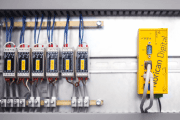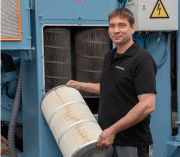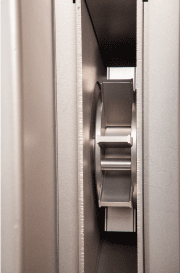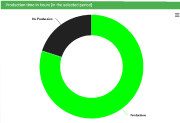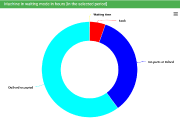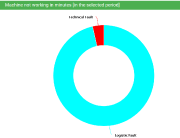What’s next in digital shot blasting?
Digital technology has accelerated its march through industry over the past 18 months, whether it’s connected production lines, data-driven foundries or digital tools for specialist processes. Partly driven by necessity and pandemic pressures (i.e. remote trouble-shooting, instant access to scarce skills or cost control), many businesses are fast discovering just how effective digital technology can be. Shot blasting is an area where Digital can make a large impact quickly.
Shot-blast machines are still among the least digitalized pieces of equipment. In production settings where they are seen as peripheral, they can be easily overlooked by Industry 4.0 projects, yet. the opportunities for process improvement are huge and it is now easier than ever to digitally enable existing machines. The last year has seen great advances in the development of practical digital tools for shot-blast equipment. Here we summarize the latest developments and take a look at what’s next in digital shot blasting.
But first, what is digital shot
blasting?
Digital shot blasting is the collection and analysis of data about individual blast processes in live production settings with the aim of improving and optimizing it beyond what’s currently possible.
It’s about building up a wealth of data on a specific process, so machine operators and managers can learn from it. But most importantly, it’s about real-time tracking of the right process parameters to detect early on if something is not right or running off course – so operators can intervene before it becomes a problem.
This enables smoother operation, a more stable process, more efficient use of energy and resources, and a better understanding of the condition of the machine and its components. As well as improving blast results and end product quality, this will make blast operations more efficient, productive and sustainable over time.
Current digital applications for shot blasting focus on creating greater visibility of real-time process parameters and on tackling the main cost drivers of operating a blast machine. But the additional potential for improved process control and traceability is immense, particularly when it comes to high-end, high-precision processes like peening.
Once a machine is digitally enabled and process data is being tracked and recorded – to tackle a specific issue, for example – it is easy to add further sensors and data sources while running different analyses or tools and onboard new digital applications.
Digitally enabling existing
equipment
Even older shot-blast machines can easily be digitally enabled by adding a network gateway like Wheelabrator’s NoriGate. These edge devices collect data from PLCs, sensors and other selected sources and send them to a central place for monitoring, analysis and storage.
NoriGate is equipment-agnostic, so it doesn’t just work on Wheelabrator machines, but can be installed on other manufacturers’ shot-blast machines and indeed many other types of equipment.
Depending on what an operator or manager initially wants to see or achieve, additional sensors may need to be installed to provide the right data points needed. This can be done over time and according to individual operational needs.
Once there is a live feed of data streaming from a machine, it needs to be received and stored somewhere. This can be an existing Industry 4.0 system or something like the Monitizer platform with Monitizer® | DISCOVER (from Wheelabrator/Norican). Through it, data can be accessed, viewed and analyzed on easily configurable dashboards or using pre-set tools.
If data is collected and viewed across a whole production line, be it in a foundry or manufacturing set-up, a digitally enabled shot-blast machine also becomes a valuable data source that not only helps improve blast operations but may give insights on other parts of the process too.
Tackling shot blasting’s cost drivers
When taking the first steps into digital shot blasting, it makes sense to start where the biggest gains can be had – by tackling the main cost drivers of running shot-blast equipment.
Starting the digital journey there means the investment pays for itself, unlocking cost savings that quickly cover the cost of the initial digital set-up. At the same time, this establishes a basis to build on, enabling operators and engineers to learn more about their process and extract ever-greater value from their data as they go along.
The team at Wheelabrator have used the same rationale to prioritize the development of a set of ready-made digital tools, built on the Monitizer platform, that tackle the top three cost drivers of running shot-blast machines:
• energy use,
• abrasive consumption, and
• maintenance.
Each tool directly addresses one cost driver to achieve significant savings, but there can be considerable positive knock-on effects elsewhere:
• Optimizing abrasive consumption can shorten cycle times, save energy and reduce wear.
• Optimizing energy use (through the clever management and minimization of idle time) and maintenance can free up capacity and maximize productivity.
Additional tools are developed all the time and become available quickly. They can be onboarded easily once a machine is digitally set up.
In parallel, Monitizer | DISCOVER also offers powerful, easy-to-use features that allow operators, production managers and engineers to build their own dashboards and tools without specialist programming knowledge. Empowering skilled workers on the factory floor to create the tools they need themselves is the fastest route to embedding data-driven continuous improvement.
A look inside the black box
A major advantage of digitalizing shot-blast equipment is that operators and managers are suddenly able to see what’s going on inside their machines- in real time!
This transparency enables them not just to understand and improve their blast processes; it also allows them to document and validate it for their customers, for cross-referencing with quality control data, and more.
For machine operators and managers on the ground, this means they can keep shot-blast equipment on the racing line at all times, saving money and resources while continuously improving blast operations.
Zooming out from the individual shot-blast machine, managers can compare performance across equipment and use blast process data as part of wider data-driven optimization efforts across whole lines or sites.
All of this means taking charge of the process and driving it the way they want to, rather than letting the machine and its needs drive them.
Understanding blast machine
effectiveness
This bigger-picture transparency opens up opportunities beyond tackling the top three cost drivers of just the blast machine, bringing the wider production context into view. The next generation of digital tools will be looking at providing a holistic picture of a blast machine’s performance.
For example, a new tool from Wheelabrator (again, available as retrofit on all types of blast equipment) pulls together key data points to give an overview of a blast machine’s overall effectiveness – across shifts and runs.
The tool captures the operating status of the machine over time alongside other parameters, enabling managers to see exactly when and for how long it is not running and why (idle times, maintenance breaks, loading/unloading, unscheduled downtime, delays on the line) versus when it is running.
Where, previously, operators were unable to see inefficiencies and hold-ups in their blast operations, the new tool allows them to track these issues and relate them to other factors like changes to machine settings or blast media supplier, product change-over, shift changes or supply issues on the line.
Simple dashboards show key metrics and benchmarks for a specific time frame at a glance, allowing comparisons and enabling quick troubleshooting.
All this means operators and managers can optimize the utilization of their shot-blast machine, improve production flow and planning, and make best use of resources. As a result, they will reduce wear and operating costs, as well as improving efficiency and productivity.
What’s next in digital shot-blasting?
The digital tools described above are delivered on a platform (Monitizer) that is already capable of running even more advanced digital technologies such as artificial intelligence (AI). These have been proven on other machine types, like moulding lines, to reduce scrap in foundry settings, for example.
Applied to shot-blast equipment, these kinds of advanced digital tools will soon further streamline maintenance (through AI-driven early warning systems, for example) and offer significant potential for cost savings. They could even eliminate unscheduled downtime entirely. For maintenance-intensive equipment like shot-blast machines, this could be a game-changer.
Highly advanced process control tools for high-spec processes are another area with great potential. There is almost no limit to the types of data feeds that could be pulled in once the digital set-up is in place. Ultimately, this means operators and managers will be able to offer complete process assurance to their customers, as well as achieving new levels of precision.
Increasingly, and on a platform like Monitizer, operators and engineers will be able to easily create new digital solutions and dashboards themselves, tailored to their process and requirements. The resulting increased process and performance visibility will mean it will be easier to ask for help and troubleshoot – whether it’s quickly getting expert advice from an engineer at the OEM or from central resource within the organization that covers more than one location.
Conclusion
The opportunities digital shot blasting can unlock are vast, yet the digital tools on offer are easy to deploy, straightforward and offer quick payback. What comes next will change blast operations forever – and for the better.
By finally overcoming some of the major historic challenges of running blast machines, digital technology will put operators in the driving seat, give them greater control, a more modern working environment and greater scope for collaboration and learning.
Ultimately, they will help build a sustainable, profitable future for industry, with connected production environments that are smarter, leaner and cleaner – and empower the people working within them.
For Information:
Wheelabrator Group GmbH
Heinrich-Schlick-Straße 2
48629 Metelen, Germany
Tel. +49.2556.880
Fax +49.2556.88 150
E-mail: kontakt@wheelabratorgroup.de
www.wheelabratorgroup.com
